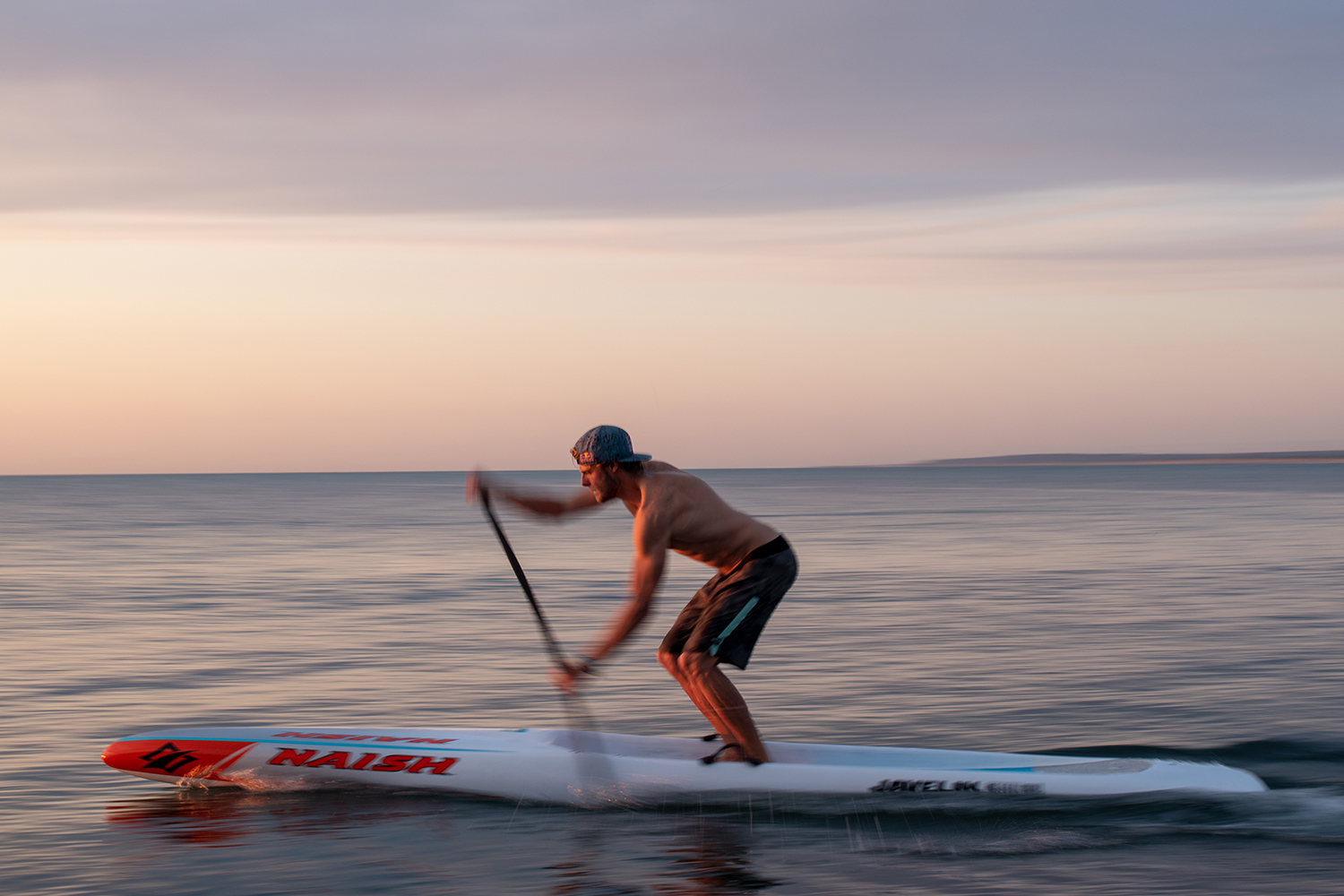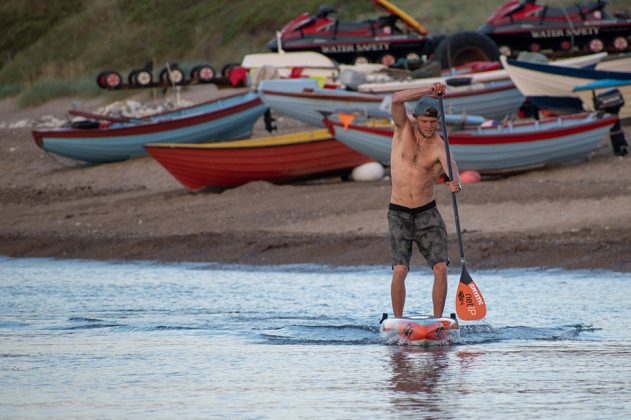PADDLE SCIENCE #16 –
SPRINT AND DISTANCE FITNESS.
Words – Kate Starling
Photos – Peter Stroebech
I admit it. Thanks to the Boardmasters Storm I haven’t been out on the water today. I holed myself up in the gym and rowed 5000m. I split my session into 10 sets of 500m with a one minute rest period in between. Sounds easy right?
I set off like a jack out of the box, nailing a magnificently high stroke rate (for me at least) for about ten seconds before I falteringly slowed up (with thoughts of WTF?) and then tried my best to smash out the rest of my meters as quickly as possible. I heaved and puffed my way through all of my too-quick rest periods before heaving and puffing more through each increasingly painful set. At the end of 5000m I hauled my poor exhausted body up into a barely standing position and wobbled off shakily to seek redemption somewhere. I found it a short stagger away at the paper towel dispenser where I proceeded to mop down my desecrated yet perhaps slightly fitter body and finally got my breath back. It got me thinking. Do you train efficiently?
Not all of us want to enter races or be the quickest paddler on the water. You also don’t need to be an athlete, have a coach or have a “training programme”. However, if you enjoy SUP and are interested in increasing your health and fitness then becoming a little more focussed over how you SUP can pay dividends. Welcome to the geeky but relevant world of energy systems.
Two main systems exist within the body which produce the energy you need during exercise: the aerobic and the anaerobic energy systems. Which system you use depends largely on the intensity and duration of your SUP sessions together with your overall fitness level. Longer, low to moderate intensity exercise will predominantly use the aerobic system whilst shorter, higher intensity exercise will predominantly use your anaerobic system. All three systems work together to replenish a substance called adenosine tri-phosphate (ATP) which is critical for energy production and indeed for every cellular process within the body.
Understanding the aerobic and anaerobic energy systems is important so that you can aim to exercise either more aerobically or more anaerobically. Notably, at no point do you only operate on one energy system alone. However, one system will always predominate and which system you use is based on the demands you place on your body. Structuring your SUP workouts will help you get the most out of your water sessions, guaranteeing better and above all more efficient fitness gains.
Aerobic Energy System
The aerobic system means “with oxygen”. This means that if you train your aerobic system your body uses oxygen to generate ATP for energy. This system also uses carbohydrates, glucose and glycogen, together with fats to help replenish ATP levels. As oxygen is required during aerobic exercise, the production of energy is somewhat slower but is able to continue for a much longer period of time compared to anaerobic exercise. This means, that the aerobic energy system is dominant during lower intensity exercise over efforts lasting longer than 2-3 minutes. It is the energy system likely to predominate during a sixty minute or five mile SUP.
Exercising aerobically can be excellent for overall physical fitness and health. The production of ATP and therefore energy occurs within the mitochondria of our muscle fibres. Mitochondria contain enzymes which, through interaction with oxygen, enable the breakdown of certain fuels such as glycogen and fatty acids. This results in the production of large amounts of energy, important in sustaining energy production over a long SUP paddle. Aerobic training not only increases the number and size of the mitochondria but it also makes your muscles far more efficient at using oxygen for fuel.
“High intensity interval paddling is a great way of helping to burn off fat and can be much more efficient at doing so compared to other forms of exercise.”
How to Train Aerobically:
• Aim to do a gentle warm up at a low intensity for ten minutes.
• Either plot out a certain distance you’d like to paddle or aim to paddle for a certain time – normally anything above 15 minutes depending on your baseline fitness. Maintain a relatively low to moderate intensity pace for the duration. The key to aerobic training is to try to maintain a pace at which you feel comfortable talking. You should be slightly out of breath but not too much.
• Aim to perform 3-5 sessions a week.
Anaerobic Energy System
In contrast to the aerobic system which uses oxygen, the anaerobic system doesn’t use oxygen to produce energy. As no oxygen is required, the anaerobic system is capable of producing energy very quickly. Two types of anaerobic systems exist, ATP-PC and glycolytic. These energy systems are used during high intensity exercise rather than slow, gentle activity.
The ATP-PC system relies on ATP which is stored within the muscles to provide energy during high intensity exercise. It also utilises a limited amount of phosphocreatine (PC) within the muscles to help regenerate ATP. Of all three energy systems, the ATP-PC system generates ATP at the fastest rate and is therefore critical for high intensity, explosive exercise. It enables you to generate a high level of power over a short period of time, for example enabling you to go all out in a 100m sprint. However, as both ATP and PC have only limited levels within the body, as they become depleted your body will begin to slow down during exercise. Overall, this energy system is only capable of producing approximately 10 seconds of peak intensity output.
Meanwhile, the glycolytic anaerobic energy system utilises carbohydrate or glycogen which is stored within your muscles. Compared to the ATP-PC system, the glycolytic system is capable of generating ATP for longer. However, at maximum intensity, this too is limited to approximately one to two minutes in length.
This means, that if you perform a period of high intensity exercise, the ATP-PC anaerobic system will first be used, followed by the glycolytic system.

Benefits of Training Anaerobically
Notably, if you’re exercising for weight loss, exercising anaerobically can be an excellent way to train. Short, high intensity bursts rely predominantly on carbohydrate stores rather than fat stores. However, during anaerobic interval training, an increased amount of fat is burned during the low intensity aerobic recovery time between efforts. This makes high intensity interval training great for fat loss. Weight loss and calorie expenditure is also further increased greatly in the hours that follow a high intensity workout. Research indicates that the resting metabolic rate can remain elevated by 15% or more up to twenty-four hours post exercise. Even better, you are more likely to continue to burn fat during this period.
High intensity interval training is therefore a great way of helping to burn off fat and can be much more efficient at doing so compared to other forms of exercise.
Anaerobic training also leads to an up regulation of all three energy systems, increasing the efficiency of each system. It can also encourage the development of fast twitch muscle fibres, required for explosive power and speed.
How to Train Anaerobically
Despite the fact it’s a short session, high intensity exercise is hard. It will challenge you mentally and physically so if you’ve never tried it before, make sure you’re prepared.
• Split your SUP workout into work and recovery times. This normally has the ratio of 1:2 or 1:3. So for example, for every 1 second of sprinting you do, you have two seconds of recovery. Start slowly and as your fitness increases make the ratio harder so that you have less recovery time.
• To activate your anaerobic glycolytic system to its maximum, aim to sprint for 30 to 60 seconds with a recovery of between 90 to 180 seconds.
• Don’t SUP too hard during your recovery period. Aim to bring your breathing and heart rate down as much as possible before you start your next sprint.
• This form of exercise needs to be intense!! If your SUP intensity is too low you need to work harder. Adapt the intensity so that you get the most out of your session.
• The length of your high intensity shouldn’t be too long. Aim for about 20 minutes. If you’re going all out at maximum effort you may only manage 10 minutes.
• Aim for 1-2 high intensity workouts a week.
• Allow adequate rest and recovery time in between your workouts.
All too often I see people not really making the most out of their fitness or training session. Not every exercise session has to have a specific goal but ask yourself what fitness gains you’re really getting and if you’re getting the most out of the time you put in? Aim to train efficiently with your SUP and you should find that you begin to make bigger and better physical fitness gains. It’s all about training smart. SUP INTERNATIONAL
Kate is a physiotherapist and standup paddler. Reach her at www.newquayphysio.co.uk


